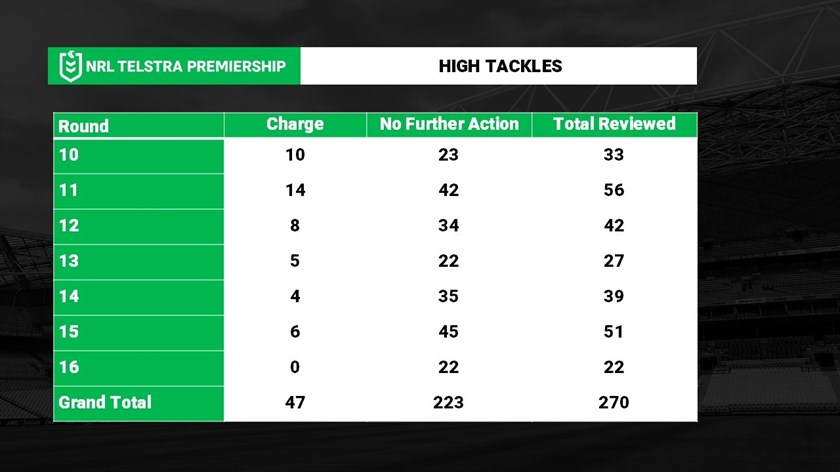A round without a high tackle charge shows the NRL's crackdown is already bearing fruit but head of football Graham Annesley has conceded the regularity of blowout margins is concerning.
No charges were laid by the match review committee for high tackles in round 16 and Annesley believes that is evidence of players adapting their techniques to a lower target zone.
But while that issue is seemingly on the improve, the topic of lopsided scores – and how they may be influenced by the six-again rule – is creating widespread debate.
With three teams held to nil last round and five sides scoring at least 38 points, Annesley admitted on Monday "there's no doubt we'd like to see scorelines closer".
However, he also sought to add "perspective" by referencing numbers that counteract the argument that top teams are beating up lowlier opponents worse than ever.

While there has been a 60% increase in 19-plus margins on last season, Annesley said the average game margin is only four points higher than 2020 and 5.4 points above 2019.
"It's telling us that we've had some of these sorts of scorelines in other seasons as well," Annesley said.
The average margin in matches involving bottom-eight teams is "flat" (12.8 points per game in 2021; 12.4 points per game in 2020), Annesley added.
Get Caught Up: Round 16 must-see moments
And the gap between top-eight and bottom-eight teams has widened by only 3.5 points compared to last season (20.7 points per game in 2021; 17.2 points per game in 2020).
The most surprising result, according to Annesley, is the 11.2-point increase in the average margin when two top-eight teams face off.
"People would think that when two top-eight teams play each other we're getting closer games and we're getting small margins. But that's not, in fact, the case this year," he said.
"We've seen the margin in those games go from 12.9 points last year to 21.4 this year. That's where we've seen the biggest increase.
"So some of the conjecture about the difference between the top and the bottom eight - it's clearly there, but we're also seeing some significant scorelines in the top in the top half of the table where teams play each other."
As for the root cause of it all, Annesley isn't sure. He said the NRL would need to collate a full season's worth of data before determining the impact of the six-again rule being expanded to cover 10-metre infringements as well as ruck indiscretions.
"It's hard to put your finger on exactly why this is happening … Clearly, there'll be no rule changes between now and the end of the season that would impact on this," he said.
Every try from Round 16
"Any thoughts I've got are purely personal and there's no basis to them other than a personal view. But I think that we are clearly seeing a situation where momentum is playing a big part in the outcome of these games.
"We've got a lot of people blaming the introduction of six-again. But when you have a look at the number of six-agains, for example, that are awarded this year for 10-metre infringements - which is the only area where we've increased six-agains - it's only two or three on average a game for 10-metre infringements.
"It's not like it's having a massive impact on the game. And we had six-again for ruck infringements last year. We definitely have taken steps over the last couple of seasons to try and make the game faster and more continuous, more entertaining.
Episode 19 - Origin III teams named, blowout issues analysed
"Continuity is important and continuity often can lead to momentum swings. I think some of the teams are struggling with trying to reverse that momentum once it starts.
"But they are all the factors that we would like to explore further between now and the end of the season, about how you can perhaps reverse some of those momentum shifts or increase those momentum shifts so that we're not seeing teams dominate with the ball for long periods of play while other teams are defending.
"It shouldn't really happen in our game because we only play six-tackle football and effectively the ball changes possession every 90 seconds or so in a six-tackle of environment."
Annesley lauded the "fantastic result" of no players being charged for high tackles over the weekend. Even the amount of high tackles reviewed by the match review committee (22) was the fewest since the high-contact crackdown was introduced in round 10.
"You can see that there's definitely a downward trend in the number of incidents that the match review committee are having to review and the number of incidents that they feel that they don't have to take any action on," Annesley said.
"And that's because when we do see these incidents, they are at the lower end of the scale … I give great credit to the players and the coaches for the way they've adjusted over the last six or seven weeks.
"To have a round with no charges for high tackling, I think it's a pretty remarkable achievement compared to where we came from."
Annesley explains Katoa knock-on decision
Elsewhere, Annesley backed the NRL Bunker's decision to overturn a try to Cronulla's Jesse Ramien for a knock-on against the Broncos.
He clarified the Bunker ruled winger Sione Katoa lost control of the ball and didn't regain it before pushing it to Ramien. While it may have looked like an offload at normal speed, Annesley said the Bunker cannot and did not rule on a forward pass.
In the same match won by Brisbane, Annesley admitted the officials erred in missing a professional foul by Cronulla's Ronaldo Mulitalo when he knocked Kotoni Staggs out of chasing a kick.

